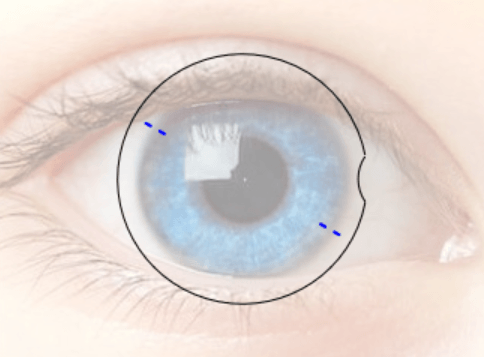Attributes
Blanchard pioneered the minimalist approach to scleral lens design and fitting with the Onefit™ Scleral Lens Platform – delivering optimal oxygenation for long-term corneal health with minimal lens mass and tear lens thickness.
All Onefit designs offer superior comfort, stability of fit, consistent vision, reduced glare and starbursts, and relief from dry eye symptoms. Onefit is ideal for active individuals and dissatisfied soft toric lens wearers. They are designed for corneas with a normal prolate profile, with or without astigmatism, post graft and irregular corneas including nipple, oval, or fruste keratoconus cases.
Onefit (14.9mm standard), and Onefit SC (14.7mm standard) – previously known as the Onefit A lens – simplify fitting for a wide range of applications. They are designed to vault a given topography with an optimal sag height, and are specified by the value of the base curve in millimeters of radius curvature; streamlining the fitting process and making it more user-friendly.
Onefit SC was developed for smaller corneas that have less flattening towards the periphery. These lenses are easier to handle for smaller palpebral fissures. With a smaller standard diameter and different paracentral edge geometry, a dedicated Onefit SC fitting set is required to reflect those distinctions with precision.
With a trial set composed of only 14 lenses, practitioners can fit:
- Normal prolate corneas
- Astigmatism (Onefit Sym-Toric)
- Irregular corneas
- Multifocal
- Oblate corneas (including oblate multifocal and toric optics)
- Any offending scleral elevation – utilizing Controlled Peripheral Recess (CPR)*
 *Controlled Peripheral Recess, or “CPR” technology, is a manufacturing process that creates a precise, controlled and reproducible peripheral recess to accommodate any scleral elevations that may contribute to lens discomfort and/or poor lens centration. CPR technology is available for Spherical, Oblate, Multifocal, Sym-Toric, Toric Haptic, and Quadrant Specific specifications.
*Controlled Peripheral Recess, or “CPR” technology, is a manufacturing process that creates a precise, controlled and reproducible peripheral recess to accommodate any scleral elevations that may contribute to lens discomfort and/or poor lens centration. CPR technology is available for Spherical, Oblate, Multifocal, Sym-Toric, Toric Haptic, and Quadrant Specific specifications.
The user-friendly CPR Tool gives you total control of CPR placement and size, simplifies the design and ordering process, and provides a visual representation of the lens design. Connect directly to the CPR Tool, along with other innovative fitting tools, at http://prod.blcalculator.com/tools/. Learn more by watching this informational video on CPR: https://vimeo.com/293963567
Onefit lenses are available in an oblate design with five Central Clearance Reduction (CCR) options to satisfy the needs of your post-refractive surgery patients.
Multifocal optics, delivering superior visual performance for today’s presbyopes, are available in both the prolate and oblate design.
Toric Haptics are available and are the preferred stabilization method for Onefit and Onefit SC. However, with smaller lenses sometimes toric haptics are not always sufficient. To that end, we developed Sym-Toric – an advanced front toric design option that requires no additional diagnostic fitting sets. Sym-Toric enhances patient comfort, consistency of vision performance, and greatly simplifies the practitioner fitting experience for scleral astigmatic patients. This design option relies on corneal shape rather than scleral asymmetry to stabilize itself on the ocular surface.
Extra Limbal Clearance (XLC) is also available for Onefit lenses, but is not available with Onefit SC, as the design already incorporates XLC.




